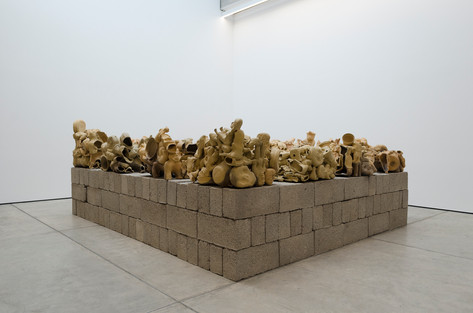Cuña, 2019
Solo Exhibition
Arróniz Galería, CDM, México
Sculptures and two-dimensional works made of adobe, mineral substrates, mud and metal structures constitute a world that emerges from history and memory and that navigates between contemporary, archaic, tradition and folklore including narratives from the Mesoamerican worldview, anthropology Politics and archeology.
Two mosaics titled ‘Mexican Formalisms’ take up fundamental motifs of Mexican architecture: the metal latticework developed by Manuel Felguérez for the National Museum of Anthropology of Mexico City, is arranged in a fragmented and irregular way seeking to establish an open dialogue between the viewer, Latin American modernity -represented by the building erected by Pedro Ramírez Vázquez- and the past in the pre-Hispanic tzompantli or Altar de los Muertos that served as a model for the architectural detail made by Felguérez.
Randall Weeks’ concern about the concepts of time, history and ideology adopts more figurative nuances in his sculptural work where he reveals his immediate references: Russian constructivism and Vladimir Tatlin, Matías Goeritz and popular culture. On one hand, a golden brass structure – made from the repetition of simple geometric figures – holds carefully placed concrete plates that contain fossilized textures of handmade fabrics and at the same time rests on an identifiable traditional element: a duffel, woven carpet very common in Mexico and Central America made from the collection of dried palm leaves. On the other, ‘Crisol‘, a large format sculpture made from pre-Hispanic figurines agglomerated and located on a brick platform, is proof of a false archaeological treasure that was sliced into a dozen bodies for its apparent historical classification and study relevant. Similarly, sedimentary plates full of arbitrary materials and colors that dissected simulate small excavations, also function as a sculptural journal that marks the time with patterns of materials specifically collected at those sites.










